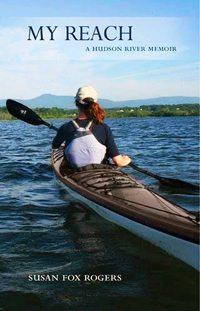By Susan Fox Rogers
Ed Note: No matter how predictable the signs of Spring, nature still surprises us on the Hudson, EarthDesk‘s home river. Here Susan Fox Rogers shares her encounter with a baby beaver on North Tivoli Bay. A rare sighting and a beautifully told tale. Turn up the volume. The sounds you hear are NOT Susan’s squeals of delight. This post also appears on Susan’s online journal. — John Cronin
I am an optimist. But on Tuesday morning as I launched my kayak onto the Hudson River at 7:30 in the morning I was not filled with my usual sense that just around the corner was the next glorious sight. I wouldn’t say I was feeling pessimistic, but rather more grumpy. And I was grumpy because the height of migration has passed–it comes and goes so quickly it is excruciating. I decided that nothing special could come my way (“all the best birds are gone” I said to a friend, sounding like a twelve year-old having a tantrum). Armed with this bad attitude, I stroked south under a bluing sky toward Magdalen Island and the entrance to the North Tivoli Bay.
Just to prove me wrong, the river first offered up a Horned Grebe, in elegant breeding plumage, floating placidly at the opening to the North Tivoli Bay. It bobbed along, as if it belonged there (it doesn’t–it should be in Canada somewhere far north). I scooted down the main waterway, lined by cattails and phragmites. Red winged blackbirds sang their insistent conkla-dee, and marsh wrens trilled from the reeds. A Map turtle sunned on a log. Two Canada Geese crossed the channel, three babies trailing behind. Fifty yards later, a Mallard mother scooted thirteen young into the reeds. I couldn’t help but laugh at myself. This was the most glorious day.

Horned grebe and map turtle. North Tivoli Bay, Hudson River, NY. Susan Fox Rogers
In the distance, I saw the tell-tale V of a beaver plowing through the water. In 1840, the beaver was a rare animal in New York State. Trapping had all but wiped out this large rodent, whose pelts were used for hats and coats. When trapping was finally prohibited in 1895, some claim there were but 10 left in the State. In the North Tivoli Bay, it is hard to believe this desperate history: I always see a beaver. Or rather, I hear a slap of a broad tail, signaling danger before the beaver dives below the surface.
So it came as a surprise when I spied a beaver snout moving toward me. About five feet in front of my kayak, the little beaver crawled up into the mud, and perched there, letting out a darling, but slightly heartbreaking mew. It then plunked back into the water and swam toward me, looping around my paddles and nuzzling the boat.
I guessed it was lost. Across the channel rested a stick pile, a beaver lodge. I moved my boat to the middle of the channel thinking the little beaver might swim to me once again and this would get it closer to home. It did. And I had the foresight to turn on the video in my pocket camera. And sure enough, after it rounded the stern of my boat, the baby beaver swam off toward the lodge.
Full of optimism, I paddled home.
«« »»
 Susan Fox Rogers is Visiting Associate Professor of Writing at Bard College. She is the author of My Reach: A Hudson River Memoir, which Philip Roth called:
Susan Fox Rogers is Visiting Associate Professor of Writing at Bard College. She is the author of My Reach: A Hudson River Memoir, which Philip Roth called:
An elegantly written and beautiful book, dominated by powerful, antithetical emotions: grief over the loss of elderly parents and exhilaration with exploring a great American river. There is Huck Finn and his raft and the Mississippi—now there is Susan Fox Rogers and her kayak and the Hudson River to add to the American canon of glorious nature writing.
Susan is also the editor of twelve books, including Antarctica: Life on the Ice and Going Alone: Women’s Adventures in the Wild. She teaches writing at Bard College where there is standing-room-only for her courses.
You can read Susan’s online journal here.
Susan’s Facebook page is here.










Thanks, Heidi, for your comment. I didn’t know that beavers had to learn to dive–wonderful fact. Diver or not, the little guy was gone soon after my little video ends. I like to think all ended well. The optimist in me.
Adorable footage, I’m glad you pointed that little lost kit home. But he likely won’t be able to get in. A beaver that small is a great swimmer but needs help diving, so young get guided by adults or yearlings into the lodge. Let’s just hope he slept on the doorstep until someone in his family woke up!
Heidi Perryman
Worth A Dam
http://www.martinezbeavers.org
Note to Ed: “A rare siting and a beautifully told tale” Yes, a beautifully told tale but a rare sighting.
Good catch, which I have corrected. Here on the Hudson we have a long history of controversies over the “siting” of things — power plants, developments, etc. So, my fingers instinctively type out the familiar. It is an old, habitual mistake. I appreciate the heads-up.